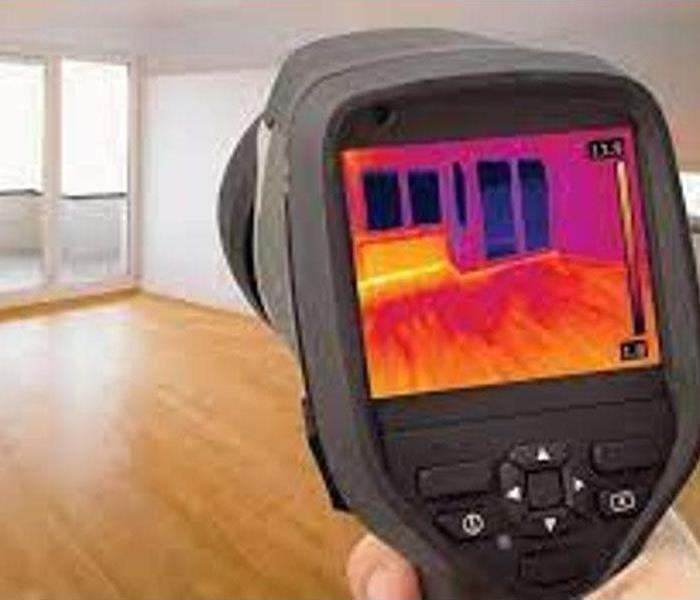Using Infrared To Detect Water Damage
10/6/2021 (Permalink)
At SERVPRO of Streamwood, Bartlett, West Chicago, & Warrenville we use infrared cameras to detect moisture in your home or business.
Thermal imaging "sees" the infrared wavelengths of heat instead of the wavelengths of visible light, which normal cameras detect. The technology has been around since the 1960s, when militaries originally used it in war to spot active factories. Now, advances in thermal technology have made higher-resolution imaging available in the palm of our hands. According to FLIR, an infrared camera is a non-contact device that detects infrared energy (heat) and converts it into an electronic signal, which is then processed to produce a thermal image or video, on which you can perform temperature calculations. Heat sensed by an infrared camera can be very precisely quantified, or measured, allowing you to not only monitor thermal performance, but also identify and evaluate the relative severity of heat-related problems.
The problem faced by most property owners is that moisture behind walls, over ceilings, and under floors is often impossible to detect until the problem is excessive and visible to the naked eye. Since the investigation and removal of infestations of not yet visible mold in structures is often difficult, technology is now being used to do what once was impossible.
The time saved using infrared, and the larger areas covered rapidly by an IR Camera, can save time and money by providing a faster, more efficient and more reliable survey. An IR camera can detect moisture located behind interior walls under the right conditions. The temperature difference created by the presence of moisture on the inside surface of a wall will appear differently than the surrounding area. IR and IT experts recommend that property inspectors or their insurers should use IR cameras and IT for moisture detection under the following circumstances.
- After any water damage event like a flood, broken water lines, equipment failure, roof leaks, etc.
- Before warranty expiration on new construction. (In many cases, those damp basement walls are explained away as "during construction" moisture. It pays to make sure before warranty expiration.)
- Before acquiring real estate suspected of having hidden moisture damage. (Don't believe the story about the house has been vacant and closed up. Musty odors are caused by moisture.)
- When basement walls are covered by finish materials, and the inspector cannot give a definitive answer on moisture issues.
- When suspected plumbing leaks have occurred from in-slab water supply and/or waste lines.
- When doors, windows, or other openings in the structure are suspected of leaking.
- When performing an energy audit of the building to determine areas of infiltration and exfiltration.
- To determine adequacy of insulation. Wet insulation is a poor insulator but is a great conductor of heat.
- Infrared inspection of the roof can determine potential for ice dams, plugged drains, and water retention that may cause roof damage and/or leakage.
- Locating hidden leakage and/or dampness under resilient flooring.
- Locating wet areas in non-accessible crawlspaces.
Infrared technology is especially useful for inspecting flat roofing systems and synthetic stucco systems, which rarely give any visual clues as to their condition or the location of leaks and moisture retention.
Finding Hidden Problems
Finding and identifying the source of water damage can be a bit tricky. Water always travels the path of least resistance, which means water coming from an upstairs bathroom might show up along a wall in your living room. Or perhaps there is a roof leak, and water is entering your ceiling and traveling to the lowest point, often a light fixture or pooling in an area near the wall.
As a home inspector, we use infrared cameras in every room to search for any signs of moisture. Frequently there is no evidence of moisture infiltration until the problem has significantly progressed. If you can catch it early, it can save the homeowner money.
For instance, sometimes a small roof leak will trickle down the underside of the roof and into the walls, where it may be absorbed by the insulation. This can go on for years with no one being the wiser. However, with a moisture meter, you may be able to detect dampness inside the walls of a room. When the home inspector identifies a wet area on a ceiling, the next step is to find out what’s up above it. It may be a hole in the roof, or it may be a plumbing leak in the bathroom upstairs. If you see a wet area in a basement, water may be seeping through the floor, but it may also be trickling in through a window, door, or crack in the wall, a camera can help us trace the water back to its origin.
While IR cameras are useful for locating hidden pockets of moisture in your home, it is just one of many tools a properly trained and qualified home inspector can use. Moisture meters should be used in combination with IR cameras to confirm the presence of water.





 24/7 Emergency Service
24/7 Emergency Service
